2017 Toyota Prius Prime
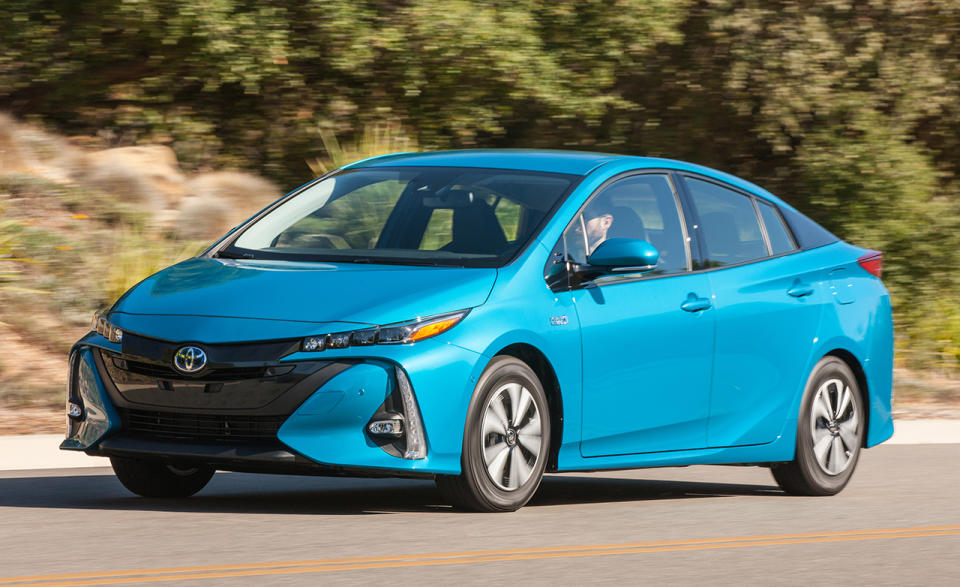
Against expectations, Toyota has made a decent business out of the Prius, a car whose picture should appear in the dictionary next to the word “frump.” Assuming the market doesn’t collapse by the end of the year, Toyota will sell well over 100,000 vehicles wearing the nameplate in 2016, a figure that is split among three models: the entry-level Prius C; the wagonoid Prius V; and the wavy-whacky new Prius, redesigned just last year by people obviously on psychotropic drugs. Henceforth, beginning with the 2017 model, Toyota is calling last year’s new Prius the Prius liftback. Why the name change? To make room for yet another Prius family member, the Prius Prime, essentially the plug-in version of the Prius liftback that, ahem, also has a hatchback.
So you’ll keep reading this story. We’ll tell you up front that the Prius Prime has a carbon-fiber hatchback made at Toyota’s Motomachi plant in Japan where the carbon-fiber Lexus LFA supercar came together. Exciting, yes?
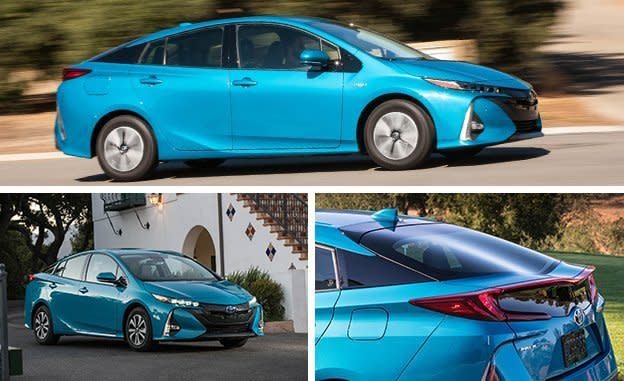
The Prime is called the Prime because Toyota figures it’s the furthest the company has taken its hybrid technology in terms of efficiency and performance. Compared with the old plug-in Prius, it’s an incremental but significant step forward in terms of both electric-driving range and fuel economy (now 55/53 mpg city/highway, for a total electric-gasoline range of 640 miles), as well as honest-to-goodness driving verve. More on that in a minute.
Twice as Much Battery
Compared with the previous plug-in Prius, the Prime gets double the battery capacity. The new 95-cell, 8.8-kWh battery pack accounts for 265 pounds of the 285-to-365-pound weight gain over the regular Prius as well as a reduction in cargo capacity of 4.8 or 7.6 cubic feet, depending on the liftback in question. But it allows up to 25 miles of electric-only driving, 10 more than the previous plug-in and 25 more than the liftback that essentially runs only as a gas-electric hybrid. A smaller, yet higher-powered, onboard charger replenishes the battery more quickly than in the old PHEV, or in 5.5 hours on household 120-volt power or two hours and 10 minutes when fed 240 volts.
Clearly, Toyota is feeling the heat from the rangier Chevrolet Volt, the Chevy’s substantially larger battery pack being able to offer 50 miles of battery-powered driving. But, counters Toyota, with a starting price of $27,965 before any federal or state tax credits, the Prime’s base price is $6130 lower than the Volt’s. Other equipment differences aside (the Prime comes standard with driver assists such as lane-departure warning with steering assist and pedestrian detection with automated braking), that’s a lot of clams for another 25 or so miles of EV driving.
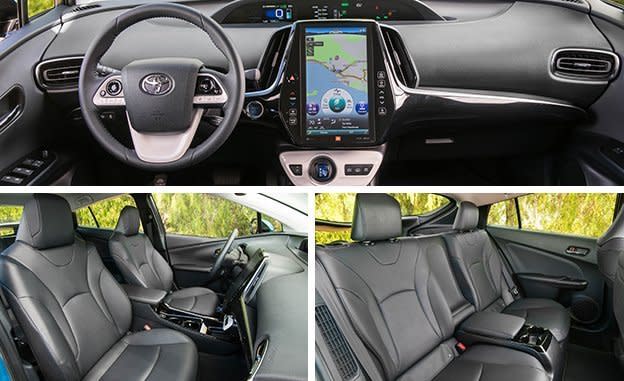
The Prius Prime also wins on EPA efficiency numbers, its city and highway ratings being more than 10-mpg better than the Volt’s and its 124 MPGe figure topping the Volt’s 106. As always with these types of cars, much depends on how you drive it, but the Prime’s advantages over its own predecessor and the Volt come in part from a rethinking of its powertrain strategy.
The 95-hp 1.8-liter Atkinson-cycle four-cylinder carries over from the Prius liftback, but the control strategy in the dual-motor transmission is changed from the old plug-in. Formerly, there was a strict division of labor, with one motor driving the wheels while the other handled ratio-changing duties in the continuously variable automatic transmission as well as charging the battery and starting the engine. Toyota’s engineers figured that latter motor had life too easy, so they installed a one-way clutch on it that now allows it to join the other motor in driving the wheels.
The main goal of teaming the motors for forward motion is to expand the envelope in which the Prime will drive in EV mode. Before, if you hit the gas pedal hard enough, the engine would be forced to pitch in as the single motor became overwhelmed. Now, with both motors pulling, the computer can leave the engine to remain as inert ballast at speeds up to 84 mph, at least until the battery depletes.
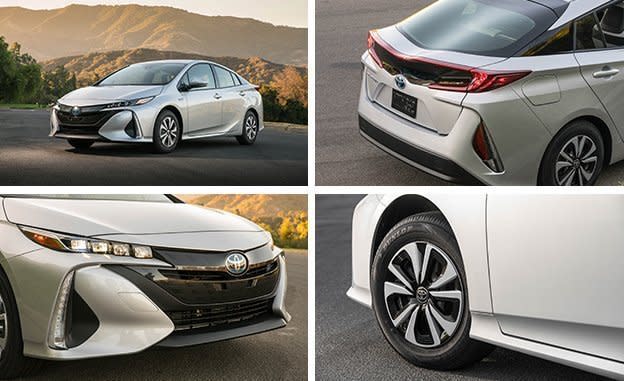
Manage Your Own Energy Use
Toyota gives the driver some input into these decisions by offering various drive modes. The default EV-only mode (called, simply, EV) runs the car solely on electrons until the battery quits, with little regard for how far you push the accelerator or how fast you’re going below 84 mph. A Hybrid mode keeps the engine running in case you want to save battery range for later, and a new EV Auto mode automatically switches the powertrain between electric and gas-electric operation depending on the power demands by the driver. Most drivers, Toyota figures, will want to start in electric and run on battery power for as long as possible—why else would you buy the plug-in (except maybe that it looks better than the liftback)?—which is why the car defaults to EV mode whenever you start it.
The Prius Prime moves away from the regular Prius visually with a restyled front and rear, supplanting the bizarro back end of the liftback with a sportier treatment that Toyota calls the “dual wave.” Whatever you call it, it’s a cleaner and more harmonious finish, even for a car with wheels so small relative to the body that it looks like a dolphin on roller skates. The Prime’s front end calms down from the Prius liftback’s impersonation of Gene Simmons as The Demon from Kiss, instead getting the sportier quad-LED headlight theme from the Toyota Mirai hydrogen car.
Inside, the news is the giant 11.6-inch, vertically oriented high-resolution touchscreen, not available on the entry Prime Plus but standard in the higher Prime Premium ($29,965) and loaded Prime Advanced ($33,965) trim levels. With swiping and pinching ability, it somewhat resembles an iPad’s ease of use. It’s really just an evolution and upsizing of the infotainment displays in current Toyota/Lexus products, which aren’t the best in the industry, and the processor is nowhere near as fast as today’s tablets. A suite of phone apps lets owners do things such as customize the recharging function to take advantage of nighttime electricity rates, monitor energy consumption, or activate the climate control to warm or cool the car in advance of departure.
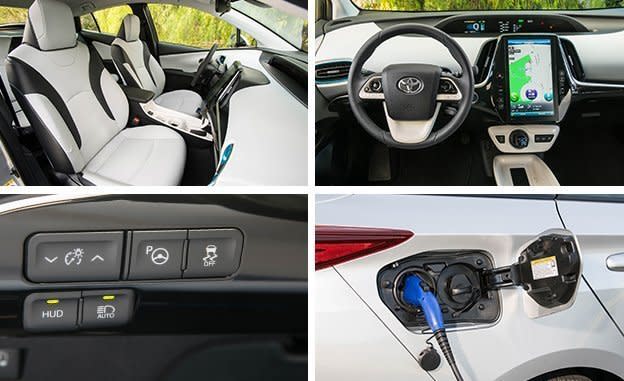
Familiar Environs, Better Experience
Owners of the previous Prius will find nothing out of place in the Prime, the centralized and stacked data displays being much fancier but exactly where owners of old Priuses last saw them. The real revelation in the Prime is the steering. When the liftback debuted last year, it had a new multilink rear suspension and a significantly stiffer structure. The Prime benefits from that as well as further suspension tweaking, and it may just have the best steering of any Toyota-branded sedan on the market. It’s organic and natural and an unexpectedly gratifying pleasure. Yes, really.
At a claimed 3375 pounds in its most upscale trim, the Prime is not particularly heavy for a car with electric capability, the carbon-fiber hatch saving about eight pounds alone. And it feels agile and fairly fleet as it moves down the road, digesting curves and undulations with a cool aplomb and a compliant but not undisciplined suspension. It is the first Prius we’ve driven that doesn’t completely drain the joy out of driving, which must bode well for future Toyota products as the brand tries to find its way out of vanilla purgatory.
The one thing Toyota should steal from the Volt is the brake-regen paddle that car features on the back of the steering wheel. In the Volt, it lets drivers activate max regen with their fingertips, allowing near-one-pedal driving as the brakes are rarely needed, the car’s momentum being converted to usable battery power rather than waste heat at the brakes. In the Prime, drivers must slap the transmission selector into B, then back to D if they want to resume normal driving. It’s much simpler in the Volt, and it easily and conveniently makes hypermilers out of anyone.
As with all plug-ins, the economics look dim on paper. To go from base Prius liftback to base Prius Prime costs $2415, or about $97 per mile of electric driving. However, Toyota figures that almost half of all drivers can stay within the 25-mile range based on their normal commutes, and 80 percent can if they are able to recharge at work, which would make the Prime a very cheap and clean—and satisfying—car to operate.
Specifications >
VEHICLE TYPE: front-engine, front-wheel-drive, 4-passenger, 4-door hatchback
BASE PRICES: Plus, $27,965;
Premium, $29,665;
Advanced, $33,965
ENGINE TYPE: DOHC 16-valve Atkinson-cycle 1.8-liter inline-4, 95 hp, 105 lb-ft; 2 permanent-magnet synchronous AC motors; combined output, 121 hp; 8.8-kWh lithium-ion battery pack
TRANSMISSION: continuously variable automatic
DIMENSIONS:
Wheelbase: 106.3 in
Length: 182.9 in
Width: 69.3 in Height: 57.9 in
Passenger volume: 91 cu ft
Cargo volume: 20 cu ft
Curb weight (C/D est): 3400 lb
PERFORMANCE (C/D EST):
Zero to 60 mph: 10.9 sec
Zero to 100 mph: 33.0 sec
Standing ¼-mile: 18.2 sec
Top speed: 115 mph
FUEL ECONOMY (MFR's EST):
EPA city/highway driving: 55/53 mpg
EPA electricity combined: 124 MPGe

 Yahoo Autos
Yahoo Autos 